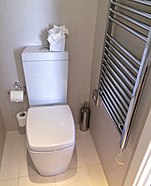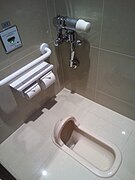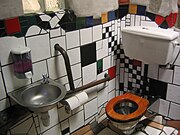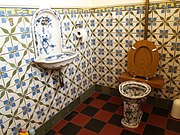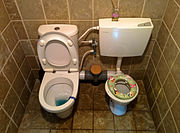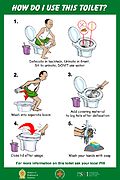Toilet
A toilet
The technology used for modern toilets varies. Toilets are commonly made of
In private homes, depending on the region and style, the toilet may exist in the same
Historically,
Overview
The number of different types of toilets used worldwide is large,[3][4] but can be grouped by:
- Having water (which seals in odor) or not (which usually relates to e.g. flush toilet versus dry toilet)
- Being used in a sitting or squatting position (sitting toilet versus squat toilet)
- Being located in the private household or in public (toilet room versus public toilet)
Toilets can be designed to be used either in a sitting or in a squatting posture. Each type has its benefits. The "sitting toilet", however, is essential for those who are movement impaired. Sitting toilets are often referred to as "western-style toilets".
People use different toilet types based on the country that they are in. In
With water
Flush toilet

A typical
The water in the toilet bowl is connected to a pipe shaped like an upside-down U. One side of the U channel is arranged as a siphon tube longer than the water in the bowl is high. The siphon tube connects to the drain. The bottom of the drain pipe limits the height of the water in the bowl before it flows down the drain. The water in the bowl acts as a barrier to sewer gas entering the building. Sewer gas escapes through a vent pipe attached to the sewer line.
The amount of water used by conventional flush toilets usually makes up a significant portion of personal daily water usage. However, modern
Another variant is the pour-flush toilet.[3] This type of flush toilet has no cistern but is flushed manually with a few liters of a small bucket. The flushing can use as little as 2–3 litres (0.44–0.66 imp gal; 0.53–0.79 US gal).[3] This type of toilet is common in many Asian countries. The toilet can be connected to one or two pits, in which case it is called a "pour flush pit latrine" or a "twin pit pour flush to pit latrine". It can also be connected to a septic tank.
Flush toilets on ships are typically flushed with seawater.
Twin pit designs

Vacuum toilet

A
Floating toilet
A floating toilet is essentially a toilet on a platform built above or floating on the water. Instead of excreta going into the ground they are collected in a tank or barrel. To reduce the amount of excreta that needs to hauled to shore, many use urine diversion. The floating toilet was developed for residents without quick access to land or connection to a sewer systems.[15] It is also used in areas subjected to prolonged flooding.[16] The need for this type of toilet is high in areas like Cambodia.[17]
Without water
Pit latrine
Vault toilet
A vault toilet is a non-flush toilet with a sealed container (or vault) buried in the ground to receive the excreta, all of which is contained underground until it is removed by pumping. A vault toilet is distinguished from a pit latrine because the waste accumulates in the vault instead of seeping into the underlying soil.
Urine-diverting toilet
Portable toilet
Chemical toilet
A
Toilet fed to animals
The
"Flying toilet"
Squat toilets
-
At Topkapı Palace, Turkey
-
Old-style squat toilet (Hong Kong)
-
In France
-
Porcelain squat toilet with water tank for flushing (Wuhan, China)
-
Japanese-style squat toilet with automatic sensor
Usage
Urination

There are cultural differences in socially accepted and preferred voiding positions for urination around the world: in the Middle East and Asia, the squatting position is more prevalent, while in the Western world the standing and sitting position are more common.[29]
Anal cleansing habits
In the
The
There are toilets on the market with seats having integrated spray mechanisms for anal and genital water sprays (see for example Toilets in Japan). This can be useful for the elderly or people with disabilities.
Accessible toilets
An accessible toilet is designed to accommodate people with physical disabilities, such as age related limited mobility or inability to walk due to impairments. Additional measures to add toilet accessibility are providing more space and grab bars to ease transfer to and from the toilet seat, including enough room for a caregiver if necessary.
Public toilets
Public health aspects
To this day, 1 billion people in developing countries have no toilets in their homes and are resorting to open defecation instead.[37] Therefore, it is one of the targets of Sustainable Development Goal 6 to provide toilets (sanitation services) to everyone by 2030.[2][38]
Toilets are one important element of a
History
Ancient history
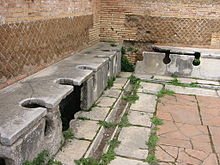
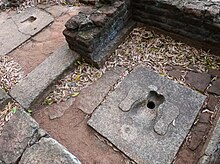

The fourth millennium BC would witness the invention of clay pipes, sewers, and toilets, in
Other very early toilets that used flowing water to remove the waste are found at
In 2012, archaeologists found what is believed to be Southeast Asia's earliest latrine during the excavation of a neolithic village in the Rạch Núi archaeological site, southern Vietnam. The toilet, dating back 1500 BC, yielded important clues about early Southeast Asian society. More than 30 coprolites, containing fish and shattered animal bones, provided information on the diet of humans and dogs, and on the types of parasites each had to contend with.[44][45][46]
In Sri Lanka, the techniques of the construction of toilets and lavatories developed over several stages. A highly developed stage in this process is discernible in the constructions at the Abhayagiri complex in Anuradhapura where toilets and baths dating back to 2nd century BC to 3rd century CE are known, later forms of toilets from 5th century CE to 13th century CE in Polonnaruwa and Anuradhapura had elaborate decorative motifs carved around the toilets.[47][48][49] Several types of toilets were developed; these include lavatories with ring-well pits, underground terracotta pipes that lead to septic pits, urinary pits with large bottomless clay pots of decreasing size placed one above the other. These pots under urinals contained "sand, lime and charcoal" through which urine filtered down to the earth in a somewhat purified form.[47]
In
The Han dynasty in China two thousand years ago used pig toilets.
Post-classical history
Garderobes were toilets used in the Post-classical history, most commonly found in upper-class dwellings. Essentially, they were flat pieces of wood or stone spanning from one wall to the other, with one or more holes to sit on. These were above chutes or pipes that discharged outside the castle or Manor house.[51] Garderobes would be placed in areas away from bedrooms because of the smell[52] and also near kitchens or fireplaces to keep their enclosures warm.[51]
-
Garderobe seat openings
-
View looking down into garderobe seat opening
-
Exterior view of garderobe at Campen castle
-
Toilet in Rosenborg Castle Copenhagen
The other main way of handling toilet needs was the chamber pot, a receptacle, usually of ceramic or metal, into which one would excrete waste. This method was used for hundreds of years; shapes, sizes, and decorative variations changed throughout the centuries.[53] Chamber pots were in common use in Europe from ancient times, even being taken to the Middle East by medieval pilgrims.[54]
Modern history



By the Early Modern era, chamber pots were frequently made of china or copper and could include elaborate decoration. They were emptied into the gutter of the street nearest to the home.
In pre-modern Denmark, people generally
By the 16th century,
In the early 19th century, public officials and public hygiene experts studied and debated sanitation for several decades. The construction of an underground network of pipes to carry away solid and liquid waste was only begun in the mid 19th-century, gradually replacing the cesspool system, although cesspools were still in use in some parts of Paris into the 20th century.
The water closet, with its origins in Tudor times, started to assume its currently known form, with an overhead cistern, s-bends, soil pipes and valves around 1770. This was the work of Alexander Cumming and Joseph Bramah. Water closets only started to be moved from outside to inside of the home around 1850.[57] The integral water closet started to be built into middle-class homes in the 1860s and 1870s, firstly on the principal bedroom floor and in larger houses in the maids' accommodation, and by 1900 a further one in the hallway. A toilet would also be placed outside the back door of the kitchen for use by gardeners and other outside staff such as those working with the horses. The speed of introduction was varied, so that in 1906 the predominantly working-class town of Rochdale had 750 water closets for a population of 10,000.[57]
The working-class home had transitioned from the rural cottage, to the urban back-to-back terraces with external rows of privies, to the through terraced houses of the 1880 with their sculleries and individual external WC. It was the Tudor Walters Report of 1918 that recommended that semi-skilled workers should be housed in suburban cottages with kitchens and internal WC. As recommended floor standards waxed and waned in the building standards and codes, the bathroom with a water closet and later the low-level suite became more prominent in the home.[58]
Before the introduction of indoor toilets, it was common to use the chamber pot under one's bed at night and then to dispose of its contents in the morning. During the Victorian era, British housemaids collected all of the household's chamber pots and carried them to a room known as the housemaids' cupboard. This room contained a "slop sink", made of wood with a lead lining to prevent chipping china chamber pots, for washing the "bedroom ware" or "chamber utensils". Once running water and flush toilets were plumbed into British houses, servants were sometimes given their own lavatory downstairs, separate from the family lavatory.[59] The practice of emptying one's own chamber pot, known as slopping out, continued in British prisons until as recently as 2014[60] and was still in use in 85 cells in Ireland in July 2017.[61]
With rare exceptions, chamber pots are no longer used. Modern related implements are bedpans and commodes, used in hospitals and the homes of invalids.
Long-established sanitary wear manufacturers in the United Kingdom include Adamsez, founded in
Development of dry earth closets

Before the widespread adoption of the
Development of flush toilets
Although a precursor to the flush toilet system which is widely used nowadays was designed in 1596 by
Flush toilets were also known as "water closets", as opposed to the earth closets described above. WCs first appeared in Britain in the 1880s, and soon spread to Continental Europe. In America, the chain-pull indoor toilet was introduced in the homes of the wealthy and in hotels in the 1890s. William Elvis Sloan invented the Flushometer in 1906, which used pressurized water directly from the supply line for faster recycle time between flushes.
High-tech toilet
"High-tech" toilets, which can be found in countries like Japan, include features such as automatic-flushing mechanisms; water jets or "bottom washers"; blow dryers, or artificial flush sounds to mask noises. Others include medical monitoring features such as urine and stool analysis and the checking of blood pressure, temperature, and blood sugar. Some toilets have automatic lid operation, heated seats, deodorizing fans, or automated replacement of paper toilet-seat-covers. Interactive urinals have been developed in several countries, allowing users to play video games. The "Toylet", produced by Sega, uses pressure sensors to detect the flow of urine and translates that into on-screen action.[65]
Astronauts on the
Names
Etymology


Toilet was originally a French loanword (first attested in 1540) that referred to the toilette ("little cloth") draped over one's shoulders during hairdressing.[68] During the late 17th century,[68] the term came to be used by metonymy in both languages for the whole complex of grooming and body care that centered at a dressing table (also covered by a cloth) and for the equipment composing a toilet service, including a mirror, hairbrushes, and containers for powder and makeup. The time spent at such a table also came to be known as one's "toilet"; it came to be a period during which close friends or tradesmen were received as "toilet-calls".[68][71]
The use of "toilet" to describe a special room for grooming came much later (first attested in 1819), following the French cabinet de toilet. Similar to "powder room", "toilet" then came to be used as a
Contemporary use
The word "toilet" was by etymology a euphemism, but is no longer understood as such. As old euphemisms have become the standard term, they have been progressively replaced by newer ones, an example of the
Regional variants
Different dialects use "bathroom" and "restroom" (American English), "bathroom" and "washroom" (Canadian English), and "WC" (an initialism for "water closet"), "lavatory" and its abbreviation "lav" (British English). Euphemisms for the toilet that bear no direct reference to the activities of urination and defecation are ubiquitous in modern Western languages, reflecting a general attitude of unspeakability about such bodily function.[citation needed] These euphemistic practices appear to have become pronounced following the emergence of European colonial practices, which frequently denigrated colonial subjects in Africa, Asia and South America as 'unclean'.[73][74]
Euphemisms
"Crapper" was already in use[citation needed] as a coarse name for a toilet, but it gained currency from the work of Thomas Crapper, who popularized flush toilets in England and held several patents on toilet improvements.
"The Jacks" is Irish slang for toilet.[75] It perhaps derives from "jacques" and "jakes", an old English term.[76]
"Loo" – The etymology of loo is obscure. The
Gallery
-
Men's toilet designed by artist and architectHundertwasser
-
Toilet in Delftware style
-
Toilet bus in Samsun, Turkey
-
Duo toilet for child training in a banquet hall near Jerusalem, Israel
-
Toilet inCroatian National Theatre in Zagreb, Croatia
-
A public toilet in Antipolo, Philippines
-
Instructions on using a urine-diverting dry toilet in Sri Lanka
See also
- Community toilet scheme
- Electronic toilet
- Green train corridor
- Human right to water and sanitation
- Improved sanitation
- Sanisette
- Sulabh International Museum of Toilets
- Sustainable Sanitation Alliance
- Swachh Bharat Mission
- Toilet humour
- Toilet-related injuries and deaths
- Vermifilter toilet
- Waste management
- World Toilet Day
- World Toilet Organization – organization which focuses on toilets and sanitation at the global level
- Workers' right to access the toilet
Explanatory notes
- ^ For a full list of English synonyms, see "toilet" in Wiktionary's thesaurus.
- ^ The French eau de toilette ("toilet water") is sometimes used as a sophisticated synonym for perfume and cologne but is generally received jokingly, as with Cosmopolitan's parody "If it doesn't say 'eau de toilette' on the label, it most likely doesn't come from the famed region of Eau de Toilette in France and might not even come from toilets at all."
- ^ Yachtsmen still tend to refer to their toilets as "loos" rather than "heads".[citation needed]
References
- ^ WHO and UNICEF (2017) Progress on Drinking Water, Sanitation and Hygiene: 2017 Update and SDG Baselines. Geneva: World Health Organization (WHO) and the United Nations Children’s Fund (UNICEF), 2017
- ^ a b "Goal 6: Clean water and sanitation". UNDP. Retrieved 28 September 2015.
- ^ ISBN 978-3-906484-57-0.
- ISBN 978-1-84380-155-9.
- ^ Gershenson, Olga; Penner, Barbara (2009): Ladies and gents – Public toilets and gender. Temple University Press, Philadelphia, Pennsylvania.
- ^ "World Toilet Day 19 November". United Nations. Retrieved 14 November 2017.
- ^ "Tucson lawmaker wants tax credits for water-conserving toilet". Cronkite News Service. Archived from the original on 2007-08-10. Retrieved 2008-03-12.
- ISBN 978-3-906484-57-0.
- ^ a b "Single Ventilated Improved Pit – Akvopedia". akvopedia.org. Retrieved 21 May 2020.
 This article incorporates text available under the CC BY 3.0 license.
This article incorporates text available under the CC BY 3.0 license.
- ^ a b "Aircraft Toilets/Toilets of the World". Toilets of the World.
- ^ "What are Vacuum Toilets?". wiseGEEK. 22 July 2023.
- ^ "Vacuum Toilet | SSWM – Find tools for sustainable sanitation and water management!". sswm.info.
- ^ "How does the toilet in a commercial airliner work?". HowStuffWorks. 1 April 2000.
- ^ "EVAC Bus Vacuum Toilet". Evac GmbH.
- ^ "Sample Designs: Floating UDD Toilets". Asian Development Bank.
- ^ "Article, Govt: Bt900bn needed (in Thailand), The Nation October 31, 2011". Archived from the original on September 6, 2012. Retrieved September 6, 2012.
- ^ Cain, Geoffrey. (April 19, 2010). "Floating toilets to clean up Cambodia's act". Global Post.
- ^ ISBN 978-3906484570.
- ISBN 978-1843801559.
- ^ a b "Fact sheets on environmental sanitation". World Health Organization. Archived from the original on 7 September 2016. Retrieved 20 September 2018.
- ISBN 978-3906484570.
- ^ a b c "Simple pit latrine (fact sheet 3.4)". who.int. 1996. Archived from the original on 3 March 2016. Retrieved 15 August 2014.
- ^ a b c "Call to action on sanitation" (PDF). United Nations. Archived from the original (PDF) on 19 August 2014. Retrieved 15 August 2014.
- PMID 23582727.
- ^ "What Is a Chemical Toilet? (with pictures)".
- ^ "Account Suspended". Archived from the original on 2015-02-24. Retrieved 2015-02-23.
- ISBN 9781843391104. Archived from the originalon 2012-11-14. Retrieved 2022-11-06.
- ^ Whitaker, Mark. 30 June 2007. "Why Uganda hates the plastic bag." BBC News. Retrieved 28 September 2007.
- ^ Y. de Jong. "Influence of voiding posture on urodynamic parameters in men: a literature review (in Dutch)" (PDF). Nederlands Tijdschrift voor urologie. Archived from the original (PDF) on July 14, 2014. Retrieved 2014-07-02.
- ^ Roberto Zapperi: Zu viel Moralismus macht den Körper schmutzig., in: FAZ, 24 aprile 2010.
- ^ Shu'aib, Tajuddin B., "Qadaahul Haajah (Relieving Oneself)", The Prescribed Prayer Made Simple, MSA West Compendium of Muslim Texts, archived from the original on 2009-08-19, retrieved 2009-03-10
- ^ "Eight surprisingly rude gestures to avoid when travelling". News.com.au. November 21, 2013. Archived from the original on 26 October 2015. Retrieved 17 July 2016.
- ISBN 9780721625973.
- ISBN 9780721625973.
Douching is commonly practiced in Catholic countries. The bidet ... is still commonly found in France and other Catholic countries.
- ISBN 978-8866490395.
- ^ H, Santiago (July 8, 2014). "A hose: the strange device next to every Finnish toilet".
- ^ manic. "World Toilet". World Toilet. Retrieved 2016-03-07.
- ^ "Work of the Statistical Commission pertaining to the 2030 Agenda for Sustainable Development (A/RES/71/313)". undocs.org. Retrieved 2022-11-06.
- ISBN 978-1-317-05953-0.
- ^ Ailes, Emma (2013-04-19). "Scotland and the indoor toilet". BBC News. Retrieved 2020-05-18.
- ^ Teresi et al. 2002
- ISBN 9781780404844.
- ^ Khan, Saifullah. "1 Chapter 2 Sanitation and wastewater technologies in Harappa/Indus valley civilization (ca. 2600–1900 BC)". Academia.edu. Retrieved 9 April 2015.
- ^ "Old toilet find offers civilsation start clues". Stuff. 2012-06-14. Retrieved 2022-11-06.
- ^ "Time capsule – Life & Style – Vietnam News | Politics, Business, Economy, Society, Life, Sports – VietNam News". 2021-04-28. Archived from the original on 2021-04-28. Retrieved 2022-11-06.
- ^ "Asia's First Toilet Discovered In Southern Vietnam". Asian Scientist Magazine. 2012-06-17. Retrieved 2022-11-06.
- ^ a b W.I., Siriweera (14 December 2004). "Sanitation and healthcare in ancient Sri Lanka" (PDF). The Sri Lanka Journal of the Humanities. Retrieved 14 December 2004.
- ^ A History of Medicine in Sri Lanka From the Earliest Times to 1948, Page 151, By C. G. Uragoda (1987), University of Michigan
- ^ Abhayagiri Vihara at Anuradhapura - Page 46, Tī. Jī Kulatuṅga (1999), Central Cultural Fund, Ministry of Cultural and Religious Affairs, University of Virginia
- ^ Mattelaer, Johan J. "Some Historical Aspects of Urinals and Urine Receptacles." World Journal of Urology 17.3 (1999): 145–50. Print.
- ^ a b Genc, Melda. "The Evolution of Toilets and Its Current State." Thesis. Middle East Technical University, 2009. Harold B. Lee Library. Brigham Young University, 2009. Web. 28 Nov. 2011.
- ^ "Middle Ages Hygiene." Middle Ages. The Middle Ages Website. Web. 28 Nov. 2011.
- ^ Powell, Christine A. "Port Royal Chamberpots Introduction." Nautical Archaeology at Texas A&M University. Texas A&M University, 1 Dec. 1996. Web. 28 Nov. 2011.
- ISBN 978-0-299-06824-0.
- ^ a b Newitz, Annalee (June 22, 2017). "Unexpected Viking toilet discovery leads to controversy". Ars Technica.
- ISBN 978-0-521-52701-9.
- ^ ISBN 0416367704.
- ISBN 0416367704.
- ISBN 0-00-713189-5.
- ^ Cole, Paul (26 October 2014). "Brutal sex killer claims having to slop out cell breaches his human rights". birminghammail. Retrieved 8 January 2018.
- ^ "Slopping out ended in Cork Prison | Irish Penal Reform Trust (IPRT)". www.iprt.ie. Retrieved 8 January 2018.
- ^ "Heritage".
- ^ "History – TWYFORD BATHROOMS".
- ^ "Fordington, Biography, Rev Henry Moule, 1801–1880". freepages.genealogy.rootsweb.ancestry.com. Archived from the original on 2011-05-09. Retrieved 2017-03-29.
- ^ Geere, Duncan. (6 January 2011). "'Toylet' Games in Japan's Urinals". Wired UK. Retrieved 20 January 2011.
- ^ "Gives Space Station Crew 'Go' to Drink Recycled Water". www.nasa.gov. Retrieved 2017-10-30.
- ^ See Egerton op cit
- ^ a b c d "toilet, n.", Oxford English Dictionary, Oxford: Oxford University Press.
- ISBN 1-85709-170-1.
- ^ Pope, Alexander (1717), The Rape of the Lock.
- ^ Bell, Vicars Walker (1953). On Learning the English Tongue. Faber & Faber.
- ^ Alison Moore, Colonial Visions of ‘Third World’ Toilets: A Nineteenth-Century Discourse That Haunts Contemporary Tourism. In Olga Gershenson and Barbara Penner (eds.), Ladies and Gents: Public Toilets and Gender (Philadelphia: Temple University Press, 2009), 97–113.
- S2CID 143947247.
- ^ "BBC h2g2". Archived from the original on 28 June 2013. Retrieved 25 June 2013.
- ^ "Toilet Inspector". Retrieved 25 June 2013.
- ^ a b "loo, n.⁴", Oxford English Dictionary.
- ^ Ross, Alan S.C. (October 1974), Blackwood's Magazine, pp. 309–316.
- ^ Ross, Alan S.C. (1954), "Linguistic Class-Indicators in Present-Day English", Neuphilologische Mitteilungen, vol. 55, Helsinki, pp. 113–149
{{citation}}: CS1 maint: location missing publisher (link). - )
- ^ Harper, Douglas. "loo". Online Etymology Dictionary..
- ^ "Why do they call it the loo?", Kottke, 16 February 2005, retrieved 1 August 2015.
- ^ "Chamber Pots". Muzeum historických nočníků a toalet. Retrieved 17 July 2016.

